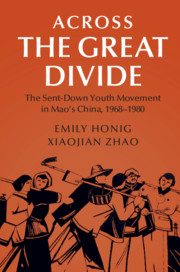Book contents
- Across the Great Divide
- Cambridge Studies in the History of the People’s Republic of China
- Across the Great Divide
- Copyright page
- Contents
- Illustrations
- Acknowledgments
- Stylistic Note
- Introduction
- 1 Farewell to the Huangpu River
- 2 Not All Quiet on the Rural Front
- 3 The Unplanned Economy
- 4 Inappropriate Intimacies
- 5 Urban Outposts in Rural China
- 6 Things Fall Apart
- 7 Epilogue
- Bibliography
- Glossary
- Index
2 - Not All Quiet on the Rural Front
Published online by Cambridge University Press: 30 August 2019
- Across the Great Divide
- Cambridge Studies in the History of the People’s Republic of China
- Across the Great Divide
- Copyright page
- Contents
- Illustrations
- Acknowledgments
- Stylistic Note
- Introduction
- 1 Farewell to the Huangpu River
- 2 Not All Quiet on the Rural Front
- 3 The Unplanned Economy
- 4 Inappropriate Intimacies
- 5 Urban Outposts in Rural China
- 6 Things Fall Apart
- 7 Epilogue
- Bibliography
- Glossary
- Index
Summary
Chapter Two focuses on the difficulties of settling urban youth in remote villages. From the beginning, the sent-down youth movement was beset with problems relating to the gap between urban and rural conditions. The municipal government received a multitude of reports that urban youth experienced inadequate housing, food, and medical facilities, and that physical labor was backbreaking and potentially injurious for individuals raised in the city. This chapter calls attention to the perspective of rural officials who, completely unprepared for the arrival of urban teenagers, faced the overwhelming job of accommodating and managing them. Given the paucity of rural resources, sent-down youth often required provisions from the city. While youth were geographically distant from their homes, and may have bemoaned the loss of their legal residence in Shanghai when their hukouwas transferred to a rural production brigade, they maintained close connections with their families in the city, on whom they depended for both financial and material goods. Most importantly, their welfare was continually monitored and managed by the Shanghai government through the sent-down youth office and its teams of Shanghai cadres stationed in areas where the city’s youth were sent—the weiwentuan ???.
Keywords
- Type
- Chapter
- Information
- Across the Great DivideThe Sent-down Youth Movement in Mao's China, 1968–1980, pp. 40 - 64Publisher: Cambridge University PressPrint publication year: 2019



